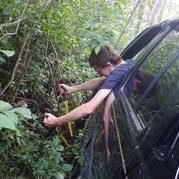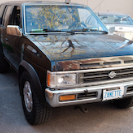Leaderboard
Popular Content
Showing content with the highest reputation on 01/14/2019 in all areas
-
It's not really that bad. If you've done a lot of car work it should be pretty straight forward. Just make sure you have a balancer puller. Also make sure you triple check the tooth count before reassembly. The first time I did one it took me 6 hours but now I can knock them out in like 2-3 lol.3 points
-
I didn't use the forum's built in search feature, I never do unless I'm trying to find somebody's profile. I agree, it's very limited/challenging to use well. I put my searches in Google prefaced with NPORA to get as many results from this site as possible.3 points
-
Actually, I don’t think there would be much issue with this. I had it attached for the longest time with the 7” rear lift and the spring still seems to have retained its shape. Its a tough little sucker. This is what I was thinking of doing, ultimately. I can’t imagine it being too difficult to extend either, just a plate with a few bolt holes. Regardless, I’ll still see if I can conduct some stop-times and hard-braking angles beforehand. Sent from my iPhone using Tapatalk2 points
-
I feel like if you put your search in quotations (sometimes you have to wait for the advanced search option to come up after searching a phrase the first time), you get pretty good results. Depends on the popularity of what you’re searching though.2 points
-
Hey everyone! A while ago, I was checking up on my rear axle's gear oil, and I started looking more closely at the strange device attached to the rear axle carrier. The one coming from under the body, attached to the axle by a spring. After a few minutes of scrolling through the factory service manual, I found that it's the load sensing valve. Essentially, the design of this valve makes it so that the vehicle can detect when there is a lot of weight in the trunk of the vehicle, or you're pulling a trailer, as the spring attached to the axle relaxes tension and the lever on the valve pushes upward, changing the valve position. This, in theory, allows the vehicle to distribute a little more braking power to the rear brakes. However, this only really applies if your axle is still the same distance from the body as it was when it was stock... Mine being 7" taller than stock in the rear, I can imagine that isn't going to do anything anymore, with how stretched the spring is. My question is, how important is the operation of this valve? I have temporarily secured it so that it remains pressed in all of the time, to try and see if I can get more smooth braking in the rear, but I don't assume that it does much in the longrun. I added a picture from the FSM of the device and its operation.1 point
-
Just as another bit of supporting evidence, Here’s some pictures from when I rebuilt my engine. The first picture is when I was taking it apart to clean it and replace the timing, the second is after. Look at the timing stuff and rear timing cover and you’ll notice loads of the dark brown dust/gunk. It was just oil residue that had been burned onto the aluminum over time. The engine was otherwise perfectly healthy. It’s a normal thing as engines get older, and this VQ was at 186,000 miles when I did this teardown. Now its bordering 200,000.1 point
-
Don’t be alarmed, I did the same thing recently after rebuilding my engine and having a misfire issue. I pulled off the oil cap, and there was some sort of residue there, and I freaked out, assuming the worst. In this case, what you’re seeing looks normal, at least from what I’ve seen. However, lets not just shrug it off immediately. What you’re likely seeing is the results of colder outside temperatures (assuming its winter where you are currently), short driving trips, or potentially a clogged PCV system (unlikely, but possible). You see, when your engine warms up, it dumps a lot of fuel to help it warm up faster and get the catalytic converters warmed up so emissions and oxygen sensors play nice. A warm engine is more efficient, and your crankshaft bearings take less of a beating at higher temperatures. While everything’s expanding due to heat, and oil is being whisked around, that excess fuel dumped into the cylinder can blow by the piston rings a little under idle/warming conditions. This is called blowby. The result is a small amount of gasoline mixing in with your oil. Conveniently, modern engines have a preventative measure for any damage that would cause, called the PCV (positive crankcase ventilation) valve system, which allows the pressure from the blowby, and the evaporating gasses from the fuel, to be safely vented into the intake to be burned off. The oil cap, being at the top of the engine, and being made of plastic, is typically cooler than the rest of the engine. Residual gasses from the oil and fuel blowby can condense on the oil cap, leaving behind a range of strange debris or colors (sometimes yellow, tan, or dark brown). This is completely normal, and should only really raise a flag if there is a lot of it, your valve covers and other sealed surfaces seem to be seeping oil, or you have poor engine performance/idle (this would indicate a possible faulty PCV valve). This sort of thing tends to pop up the most during colder weather, and especially in winter climates, due to short trip driving or letting the engine idle up to temperature for too long. So now that you have an idea of what the issue COULD be, it’s a lot less alarming. I really wouldn’t worry, but lets check a couple things! First of all, you said you changed the oil. By dumping the oil or checking the dipstick, a very alarming and fast indication of a blown head gasket would be a milkshake-like oil substance. Usually, it looks a lot stranger than brown sludge, so cross that off your list. Do a quick google search on blown head gasket oil, and you’ll see what I mean. It doesn’t take much for the coolant and oil to mix to make the nasty stuff, and you’d definitely notice it if it were severe enough. You also mentioned checking the radiator. While it’s less likely for the oil to make its way into the cooling system with a head gasket issue, it’s still possible, of course. Typically, the exhaust gasses are what make their way into the coolant, and while it can be hard to detect, there are texting kits for about $40 at local auto parts stores that allow you to test and see if you have exhaust gasses in your cooling system. They’re pretty simple to use, but you might only want to for peace of mind if you’re still not convinced. If you want to put some time into diagnostics further, pull your spark plugs and look at the color of the ceramic tips around the electrode. There are plenty of images online that can tell you how to “read” your spark plugs to know if you’re burning oil, running rich, lean, or have a head gasket problem. If it’s a small leak, it may not be noticeable. While you’re at it, rent a compression tester, check cylinder compression, and perform a leakdown test on the cylinders. This can be one of the fastest ways to indicate a failure of some sort, whether it’s a compression issue, valve issue, or head gasket. You could also rent a cooling system pressure tester. If you have a borescope, this can be really useful, but not everyone has one. You can perform a leakdown test according to the factory PSI specs of the vehicle. Typically, if it holds the indicated pressure (typically 13 PSI for older pathfinders), for 5 minutes or more without dropping significantly, you’re fine. Take it with a grain of salt, because a rental kit may not be 100% accurate, and could leak down even if you don’t have a leak, but it’s usually very slow. Sometimes, if you’re lucky (and unlucky I guess), coolant will come out of the damaged part of the head gasket around the heads or block, indicating failure. With a borescope, in short, you could look in each cylinder after a leakdown test to see if there is any coolant puddled up on the piston. Finally, an old trick from one of my mechanic buddies: Get a white piece of printer paper. Take the dipstick and wipe it off, dip it again for fresh oil, and put a good drop of it on the paper. Try and keep it as collected as possible and not splattered all over it. Let it sit until it soaks into the paper all of the way. It could be a while. If there is any small residue from a head gasket failure, typically it’ll sit on top of the paper and not soak in. Otherwise, the oil should soak into the paper and have very little variances in color. Obviously this is no engineering test, but it’s another quick and easy one for peace of mind. With all of this in mind, “brown sludge,” as you called it, could potentially be a different issue, sludge buildup. This comes with a range of other symptoms, however, and can be found various ways. If the previous owner took good care of her and did routine oil changes, cross that off your list. Regardless, throwing in a little Seafoam into the oil a few hundred miles before your next oil change can’t hurt, and could break up any potential sludge you do have (I usually drain about a quart of oil, dump a bottle of seafoam in, and run it like that for a day, changing the oil the next day). Good luck! Let me know if you have any questions!1 point
-
1 point
-
Redone the clock install on my 97 Quey. Mr Cox 96R50-97JR501 point
-
AC has the poly sway bar bushings. I think there may be sway bar links with bushings back there as well. With regard to rear upper & lower control arms, be aware that this is something[mention=37543]TowndawgR50[/mention] is starting to produce. See@Jax99 build thread.1 point
-
My trailing arms are pretty donezo, any recommendations for them? Should I replace the sway bar bushings with poly bushings?1 point
-
I was thinking less of damage to the spring and more of your brake bias changing depending on which way the axle was flexed. The stock bracket has the spring connected pretty close to what I assume is the "pivot point" on the axle (assuming the diff stays about the same distance from the body as the axle articulates). Add seven inches to that arm and the end of it will move back and forth more as the axle flexes. Enough to matter? That I don't know.1 point
-
hey all its boz from bend oregon. thought its about time to get on the forums since my new pathfinder is nice enough to fix(i.e. its not a gambler 500 race truck). i am a long time lurker from when i had my hardbody till the 99 gambler, till the new one i attained last week. glad to have found ya guys again regards boz1 point
-
Seems like the easiest way would be to extend the bracket on the axle, but then it would be yanking the spring when the rear end articulates, which is less than ideal. The best way to preserve the geometry would be to make a bracket to lower the LSV towards the axle, but then you'd probably have to extend the brake lines. And yeah, I just Google NPORA + whatever I'm looking for.1 point
-
Thanks RainGoat. I'm pleased with it and for $50 you can't beat the improvement. My OEM lights are so bad I drove right by a state trooper on bright and they didn't do anything.1 point
-
So here’s a followup on the issue: This was a user-induced issue, as I modified the PCV system slightly when changing my intake for a snorkel setup. I put a small breather filter on the PCV breather inlet, instead of reconnecting it to the intake. By doing so, crankcase pressure and gasses caused oil to buildup in that filter until it was barely breathing and clogged. The engine only had one area it could vent crankcase pressure, which was the PCV. With the PCV constantly blasting pressure into the intake manifold, oil could be picked up at that velocity, spitting oil into the intake manifold. If you look at the lower plenum, before the manifold collector on the VQ, the PCV releases pressure and gasses through a tube right above the intake valves for cylinder 4 and 6. Noticing a small trickle of oil draining into cylinder 4, that would explain a lot. The oil would get into that cylinder and take a moment to burn off when starting the engine, causing the misfire. That would also explain why cylinder 4 was the only culprit. By fixing the PCV intake so that it is connected to the air intake, as originally designed by Nissan, all the small oil seepage around the engine has stopped, the intake doesn’t have oil in it, and it seems happier altogether. The misfire still persisted after doing this fix, until I changed the spark plug for cylinder 4, which would make sense if it was burning the oil off in that cylinder. Lesson learned? The PCV system is important and designed the way it is for a reason. Don’t mess with it. If you suddenly have a misfire upon starting, and it points to cylinder 4, check your PCV intake for blockages, and replace the $2 PCV valve. For just a few hours and a couple dollars, it saves a bit of headache.1 point
-
I was waiting for you to come along with input! From the looks of the second posting, it seems rather important. The user explaining it gives quite a bit of detail about the impact it makes. Maybe I’ll go ahead and get out the grinder and some steel, see if I can’t make an extended bracket. (I swear the search feature on Tapatalk Mobile is absolutely useless. I tried searching for threads related to this and it just finds stuff completely unrelated...)1 point
-
These threads leave some questions unanswered, but may contain information handy to anybody who plans to dig into this further.1 point
-
I can definitely run some tests as soon as I can, to see what sort of impact the valve has, especially with a lift. My take on it, while some things are always questionable, the engineers put it on there for a reason, not just for extra accessories. If tests are conclusive that the valve does indeed enhance rear braking with a lift, I can’t imagine it’ll be hard to make a writeup on a bracket that could fix this. I could probably design and fabricate one in a day.1 point
-
1 point
-
Odd that they don't carry any basic parts, but they should at least be able to order them. What company is it? Is it a chain or is it at least associated with one of the major chains? In addition to RockAuto, which has good prices and Slartibartfast has a valid point regarding shipping in his post above. Don't forget to check the vendor section for a discount code, you can also use Advanced Auto. Search the web for discount codes for Advance Auto if you go that route, they always have them and they always save a bunch of money.1 point
-
1 point
-
Loaded the bikes and some people up and went for a ride yesterday, the weather was amazing. After riding on the AC springs in the rear for a few weeks I love how they ride. They are definitely very stiff but I enjoy it, especially when loaded up the springs sat level, and that was with the bike rack, 4 bikes, and 4 people in the truck. Really enjoying the better handling as well!1 point







